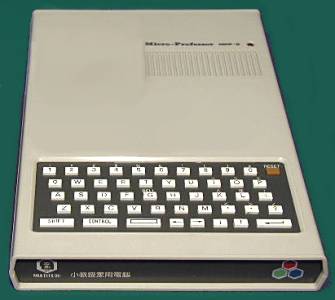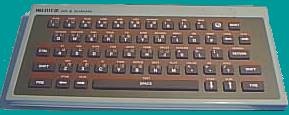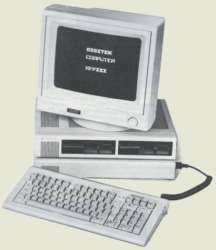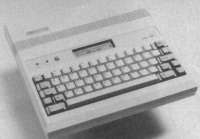
|
Manufacturer |
Multitech (Taiwan), later known as Acer |
Model |
Microprofessor II (or MPF-II) |
Date Launched |
Mid 1982 |
Price |
£269
Reduced to £200 by late 1982 |
Microprocessor type |
MOSTEK 6502 @ 1 MHz |
ROM size |
16 kilobytes (12 KB for BASIC) |
Standard RAM |
64 kilobytes |
Maximum RAM |
64 kilobytes |
Keyboard type |
Small 48-key QWERTY keyboard with calculator type keys.
BASIC words could be entered by pressing Shift+Control+one key and a keyboard overlay printed with the keywords was provided.
A separate full-size keyboard with 55 rubber keys was an optional extra: |
Supplied language |
BASIC - almost identical to Apple BASIC.
A simple assembly language monitor was also included in the ROM.
Forth, Pascal and Logo were available on plug-in cartridge. |
Text resolution |
40 characters x 24 lines |
Graphics resolution |
40 x 40 or 280 x 192 pixels |
Colours available |
8 ?
Any pixel could be any colour. |
Sound |
Single channel |
Cassette load speed |
300 baud ? |
Dimensions (mm)
Weight (grams) |
180 x 250 x 30
815 |
Special features |
The MPF-II was advertised as being able to run Apple II software.
Chinese BASIC could be added, which allowed commands and variables to be typed in Chinese 'radicals', and displayed Chinese characters on the graphics screen. |
Good points |
Ability to run Apple II programs meant plenty of software was available.
Could do most things an Apple II could at less than half the price. |
Bad points |
Strange slab-like styling.
Poor built-in keyboard which was uncomfortable to use.
Compatibility with the Apple II was not perfect and some software, especially graphics-based, would not work.
Unlike the Apple, the MPF-II had no internal expansion slots. |
How successful? |
Apparently popular in some markets, but hardly known in the UK. |
Comments |
There were some differences between the Apple II and MPF-II in terms of the display in text-only mode, and the memory address of the alternate graphics buffer was different. This meant that some programs which relied on these features of the Apple did not work on the Micro-Professor II.
There were numerous clones of the (good but expensive) Apple II around in the early 1980s. Many of these were almost exact copies and Apple successfully sued some of the manufacturers. It seems though that the Micro-Professor II was sufficiently different to avoid copyright infringement.
The Micro-Professor II looked like good value for anyone attracted to the Apple II but put off by its price, and who was mainly interested in writing their own programs. The MPF-II had better graphics and BASIC than the contemporary Sinclair Spectrum and Oric 1, which were not much cheaper, and it is surprising it did not sell better.
Read a magazine review of the MPF-II from 1982.
 Later came the MPF-III, (right, with optional twin floppy disk drives), introduced in October 1983, which was styled on the IBM PC and much less ugly than the MPF-II. The MicroProfessor III was mostly compatible with the Apple IIe and included internal expansion slots and a good quality separate keyboard. The MPF-III appears to have been aimed at small business users but does not seem to have been marketed much in Europe or North America. Later came the MPF-III, (right, with optional twin floppy disk drives), introduced in October 1983, which was styled on the IBM PC and much less ugly than the MPF-II. The MicroProfessor III was mostly compatible with the Apple IIe and included internal expansion slots and a good quality separate keyboard. The MPF-III appears to have been aimed at small business users but does not seem to have been marketed much in Europe or North America.
 In 1985 Flight Electronics Ltd launched the MPF 1/88 (left) which used the Intel 8088 16-bit microprocessor, as used in the first IBM PC. It was designed for learning and prototyping and featured 48 KB of RAM, 16 KB of ROM, a two-line by 22 character LCD display, a proper keyboard, an expansion bus to interface with IBM PC cards, and a cassette interface, all for £325. In 1985 Flight Electronics Ltd launched the MPF 1/88 (left) which used the Intel 8088 16-bit microprocessor, as used in the first IBM PC. It was designed for learning and prototyping and featured 48 KB of RAM, 16 KB of ROM, a two-line by 22 character LCD display, a proper keyboard, an expansion bus to interface with IBM PC cards, and a cassette interface, all for £325.
Eventually there was even an MPF-PC as Acer began to move into IBM-compatible clones. |

